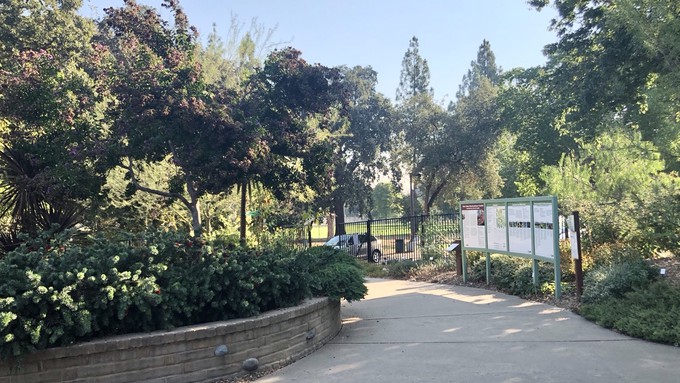
Master gardeners will be on hand to answer questions and show off what's growing now

The Welcome Area of the Fair Oaks Horticulture Center is shady and cool in the morning hours. Kathy Morrison
It’s going to be cooler Saturday. Yes, really. And everything in the Fair Oaks Horticulture Center will be looking as good as possible for visitors to Open Garden Day from 9 a.m. to noon.
The Sacramento County master gardeners’ Open Garden Days aren’t quite the productions that Harvest Day is: no speakers or vendor booths, for example. But there will be plenty of master gardeners on hand, working in the FOHC’s gardens and available to answer all kinds of gardening questions.
The 2023 Garden Guide and Calendar also will be on sale during Open Garden. Just $10, it is a great resource throughout the year -- and makes a nice gift, too. Proceeds benefit the master gardener program.
Open Garden Day is free and open to the public. The Horticulture Center is at 11549 Fair Oaks Blvd., south of Madison Avenue and the Fair Oaks Library. For a map and details: https://sacmg.ucanr.edu/?calitem=521778
Incidentally, applications for the 2023 master gardener training class open tomorrow, Sept. 9. So if you’ve ever envisioned yourself as a master gardener, this could be the year to apply! Sacramento County’s program does not train every year; the class of 2020 is the most recent one. Applicants must be residents of Sacramento County; other counties have their own training programs.
The application period closes Oct. 17. Applicants can attend one of two “Meet the Master Gardeners” events, at 7 p.m. Oct. 18 or 9 a.m. Oct. 19 at the UCCE office, 4145 Branch Center Road, Sacramento.
What is a master gardener, anyway? They are all ages but generally are volunteers who educate home gardeners through workshops, events, presentations and the online and phone Help Desk, sharing UC research-based home horticultural information with the public. New master gardeners are required to put in 50 hours of volunteer time the first year; veterans have a 25-hour requirement. Twelve hours of continuing education per year also is required for all master gardeners.
Hint from a member of that 2020 class: Folks with a history of or interest in volunteering — in any capacity, church, school, community, whatever — do very well. Gardening interest, but not expertise, is expected. It also helps if you like a good research hunt. As my class was told, “We don’t expect you to memorize everything, but we expect you to know where to look it up.”
More information on the training program is here: https://sacmg.ucanr.edu/Master_Gardener_Training/
– Kathy Morrison
Comments
0 comments have been posted.Sacramento Digs Gardening to your inbox.
Sites We Like
Garden Checklist for week of May 12
Get your gardening chores and irrigation done early in the day before temperatures rise.
* Plant, plant, plant! It’s prime planting season in the Sacramento area. Time to set out those tomato transplants along with peppers and eggplants. Pinch off any flowers on new transplants to make them concentrate on establishing roots instead of setting premature fruit.
* Direct-seed melons, cucumbers, summer squash, corn, radishes, pumpkins and annual herbs such as basil.
* Harvest cabbage, lettuce, peas and green onions. This heat will cause leafy greens and onions to flower; pick them before they bolt.
* In the flower garden, direct-seed sunflowers, cosmos, salvia, zinnias, marigolds, celosia and asters.
* Plant dahlia tubers. Other perennials to set out include verbena, coreopsis, coneflower and astilbe.
* Transplant petunias, marigolds and perennial flowers such as astilbe, columbine, coneflowers, coreopsis, dahlias, rudbeckia and verbena.
* Keep an eye out for slugs, snails, earwigs and aphids that want to dine on tender new growth.
* Feed summer bloomers with a balanced fertilizer.
* For continued bloom, cut off spent flowers on roses as well as other flowering plants.
* Got fruit trees? If you haven't already done so, thin orchard fruit such as apples, peaches, pears, pluots and plums before they grow too heavy, breaking branches or even splitting the tree. Leave the largest fruit on the branch, culling the smaller ones, and allow for 5 to 6 inches (or a hand's worth) between each fruit.
* Thin grape bunches, again leaving about 6 inches between them. For the remaining bunches, prune off the "tail" end, about the bottom third of the bunch, so that the plant's energy is concentrated in the fruit closest to the branch.
* As spring-flowering shrubs finish blooming, give them a little pruning to shape them, removing old and dead wood. Lightly trim azaleas, fuchsias and marguerites for bushier plants.
* Add mulch to the garden to help keep that precious water from evaporating. Mulch also cuts down on weeds. But don’t let it mound around the stems or trunks of trees or shrubs. Leave about a 6-inch to 1-foot circle to avoid crown rot or other problems.